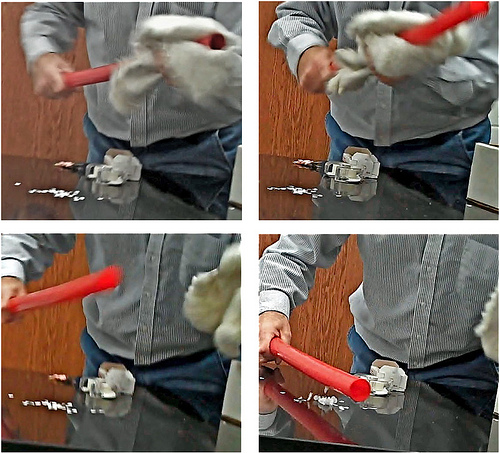Electrostatic Discharge
claimed by Dmcburnie3, edited by Duncan Mackie (Fall 2016)
Electrostatic Discharge (ESD) is the swift transfer of charges between objects at different potentials. ESD commonly occurs after the accumulation of static electricity on a material and can have devastating effects on solid-state electronics.
Material Sources of this Phenomenon
Both insulators and conductors are sources of ESD. All materials are defined on the Triboelectric series as either positive or negative, with positive and negative charges usually accumulating on naturally occurring surfaces and on synthetic materials, respectively. Sparks and lightning are visible Electrostatic Discharge events and the total amount of charge that can accumulate on a material depends on how well it can store charge. It is common for static electricity to accumulate on people and clothing in environments where sensitive electronic equipment must be protected. During the process in which electronic components are assembled most manufacturers implement create Electrostatic Discharge Protected Areas (EPA) for this work to be conducted in. These areas are to prevent the build up of charge on the components, workers, and all other conductive materials
Causes of Electrostatic Discharge
Electrostatic Discharge can be caused by an electrical breakdown, a short circuit, and most commonly, contact or near contact, due to tribocharging. Tribocharging is the separation of electric charges that occurs when objects make contact and then are separated. The Triboelectric method describes how this happens when materials are rubbed together (frictional movement) and separated. ESD is measured using an electrostatic voltmeter. To protect against Electrostatic Discharge, antistatic bags act as Faraday Cages to protect sensitive devices from ESD during the transit.
Its Effect on Electronics
ESD events, like a spark from a human hand, allow current to travel to the ground through electronic devices, burning holes in integrated circuits and dealing heat damage to the circuit board. This can happen when working barehanded (without an electrostatic wrist strap) with circuit boards and other sensitive electronic equipment, when negatively charged synthetic materials are on or near sensitive electronic equipment, or due to the fast movement of air near electronic equipment.
ESD in Aerospace
Electrostatic Discharge is connected to Aerospace Engineering by how potentially dangerous it is to not guard against ESD in environment's in which many different electronic devices are integrated into air and spacecraft. Aerospace research agencies, such as NASA, JAXA, or RKA, and corporation, such as Lockheed Martin, have implemented ESD protected areas and grounded workbenches, mandated the use of protective equipment, introduced protocol in which charge generating materials cannot be worn in protected areas, and have audits and inspections to make sure important aerospace electronics stay protected from ESD.
The Physics Principals and Visual Aids
The objects near the top (of the list above) will tend to gain negative charges, while those below them will gain positive charges. The law of Conservation of Charge is followed.
First, a tube made out of plastic is charged when rubbed with synthetic fur (top pictures). The tube, which is now charged, is brought close to neutral paper bits on the table (bottom left). You can see that the tube and paper now attract each other and that this attraction is strong enough to lift the pieces of paper off the table.
Connectedness
1. The concept of Electrostatic Discharge (ESD) can be applied to many practical scenarios; however, one of the most notable instances of ESD is in the electronics manufacturing industry. Due to the fact that charges can accumulate relatively easily in electronics manufacturing, companies often have to take ESD precautions by making employees wear special clothing and by designing their workbenches and flooring out of special material which prevents electrostatic build up.
2.Electrostatic Discharge is connected to my major because in chemical engineering plants there is a great deal of equipment that has the potential to acquire electrostatic charge. As a result it is important for safety reasons to be knowledgeable and cautious when dealing with such equipment in order to reduce work related injuries.
3.One interesting way that ESD can be used is to create sparks. When the dielectric between two oppositely charged sources is damaged or if the electric field due to the build up charge exceeds the dielectric then ESD can occur by means of a spark through the air or other dielectric medium.
History
The phenomena of electrostatic discharge (ESD) has been known for a very long time dating all the way back to the ancient Greeks. While ESD was mostly considered a non-factor throughout most of history, recently since solid state electronics started to become big in the 1950's companies and researchers have had to account for and study in greater detail the phenomena of ESD. As the prevalence of electronics increased people began to notice the ESD could have very negative effects on certain components causing them to short-circuit or malfunction. The 1960s and 70s were characterized by companies discovering methods and techniques to test for ESD some of which included the Human Body Discharge Model and the Horizontal Coupling Plate. In the 1980's the release of the IBM personal computer saw an increased need for materials with resistance to ESD and thus the focus shifted towards maximizing the ability of electronic components to avoid ESD and subsequent malfunctioning. Since the 1980's and well into modern times, companies have been working to hone and refine this process in order to maximize the efficacy of their circuit components by increasing their ability to resist ESD when in use.
See also
http://www.physicsbook.gatech.edu/Charge_Transfer
http://www.physicsbook.gatech.edu/Charge_Motion_in_Metals
http://www.physicsbook.gatech.edu/Polarization
https://en.wikipedia.org/wiki/Michael_Faraday
Further reading
Electro Static Discharge: Understand, Simulate, and Fix ESD Problems, 3rd Edition
External links
http://www.physicsclassroom.com/class/estatics/Lesson-2/Charging-by-Friction
References
Aaq.auburn.edu,. 'Summary | Academy Of Aerospace Quality'. N.p., 2015. Web. 5 Dec. 2015. (http://aaq.auburn.edu/node/277)
Michaels, Ken, AYMAN ZAHER, and Stan Herron. 'Electrostatic Discharge: Causes, Effects, And Solutions'. Ecmweb.com. N.p., 2013. Web. 6 Dec. 2015. (http://ecmweb.com/content/electrostatic-discharge-causes-effects-and-solutions)
Physicsclassroom.com,. 'Charging By Friction'. N.p., 2015. Web. 6 Dec. 2015. (http://www.physicsclassroom.com/class/estatics/Lesson-2/Charging-by-Friction)
Hoolihan, Daniel D. "A Brief History of Electrostatic Discharge Testing of Electronic Products Read More: Http://incompliancemag.com/article/a-brief-history-of-electrostatic-discharge-testing-of-electronic-products/#ixzz4R5MRIIIQ Follow Us: @incompliancemag on Twitter | Incompliancemag on Facebook." INCompliance. ECM Consulting, 01 Mar. 2014. Web. 25 Nov. 2016.

